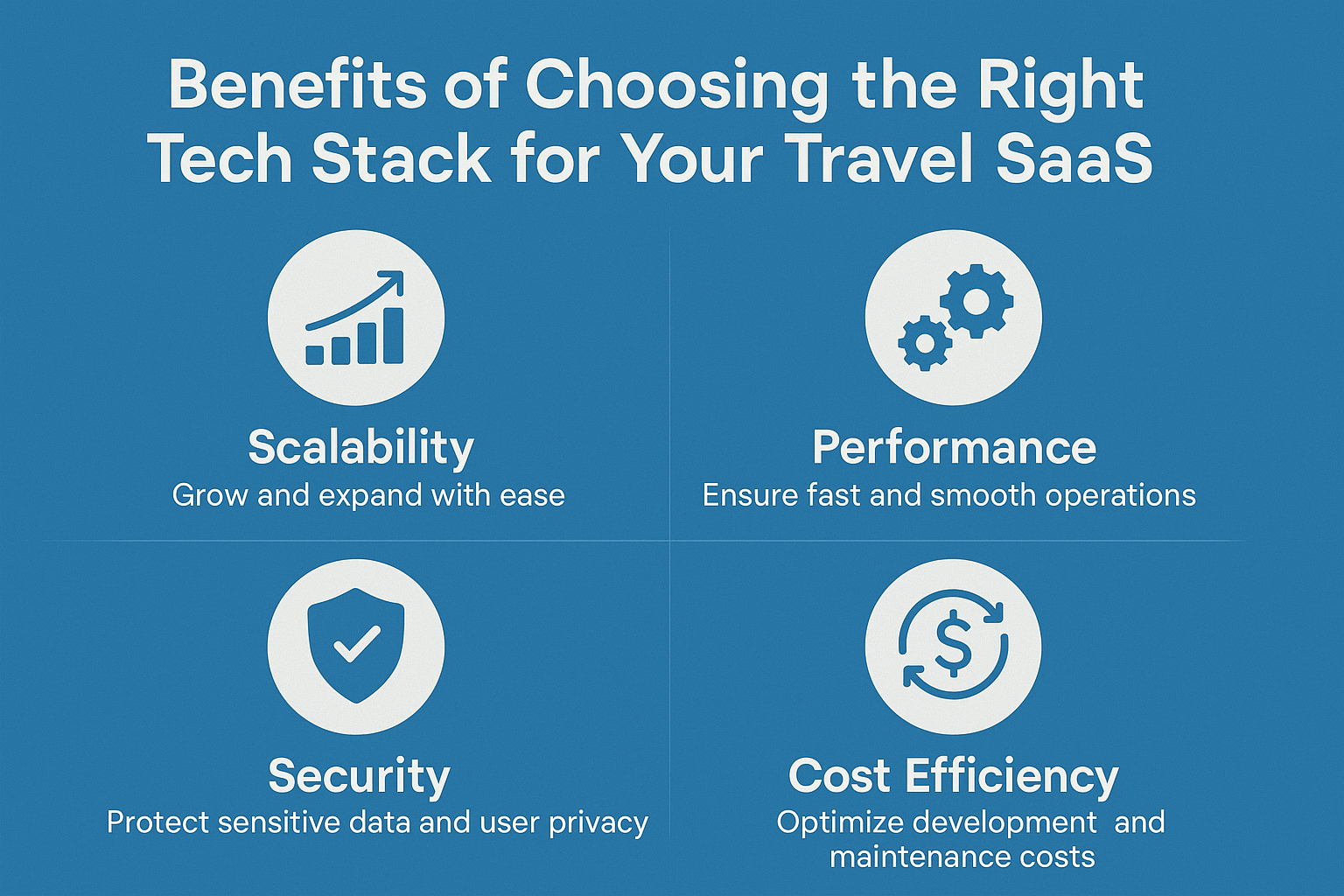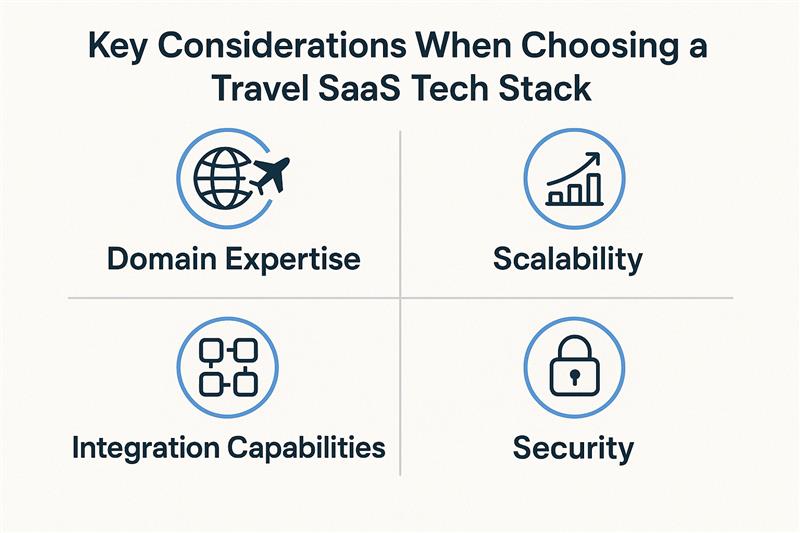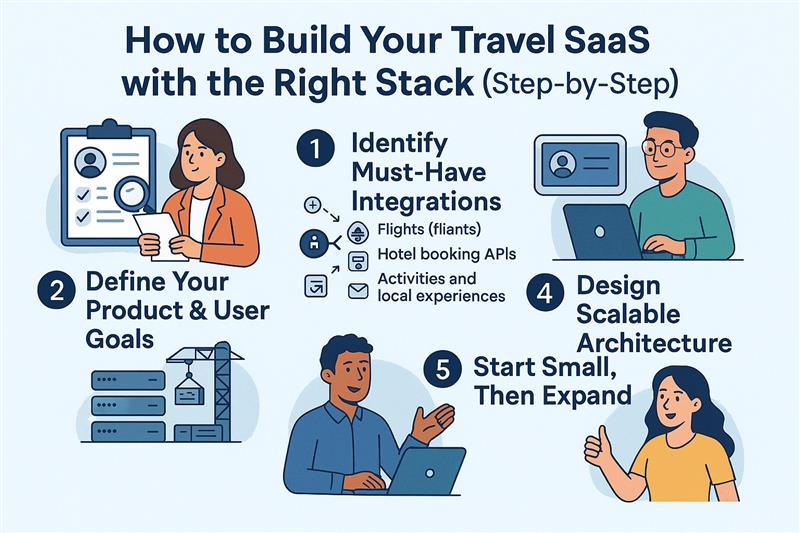
Travel
How to choose the right tech stack for your Travel SaaS development
Introduction: Why Tech Stack Matters in Travel SaaS
The travel business now operates in a fresh age where speed together with personalized services and digital platforms define what customers expect. Businesses that handle real-time inventory along with loyalty programs and dynamic pricing need the proper technology stack to remain competitive in today's market.
Your technology infrastructure serves as the primary base which supports your Travel SaaS platform development. Your technology choices extend beyond coding because they enable your business to grow while you outpace market rivals through speed and innovation. Your infrastructure establishes the level of flexibility you have when developing B2B travel booking platforms or white-labeled portals or dynamic packaging engines.
Why the Right Tech Stack Matters
The technology stack of your travel SaaS platform acts as the fundamental success factor for your business.
- Speed & Performance: The right backend ensures smooth booking flows, fast APIs, and minimal downtime.
- Scalability: The platform must accommodate growing traffic and data alongside integration requirements without needing constant repair.
- Security & Compliance: Travel data is sensitive. Modern stacks provide built-in encryption together with GDPR support and robust authentication features.
- Integration Friendly: Travel SaaS isn’t built in a bubble. You need to plug into GDSs, hotel APIs, payment gateways, CRMs, and more.
- Maintainability: Clean, modular code means your dev team can iterate quickly without breaking things.
- Future-Proofing: Cloud-native, microservices-based architectures keep you ahead of tech shifts and customer needs.
Travel SaaS requires developers to create an intelligent adaptable system which expands with customer and partner requirements.
Before starting features or UX development you should evaluate your tech stack because it determines whether you lead or follow.
The Shift from Traditional Travel Tech to Custom SaaS Platforms

For many years travel businesses depended on legacy systems which consisted of complicated interfaces and old databases with limited adaptability. These platforms functioned through white-label solutions and reseller models which let businesses distribute travel inventory through different brand technologies. The present time shows a quick transformation of the travel business landscape.
The travel industry now demonstrates a growing trend of adopting personalized SaaS platforms which adapt to their distinct operations and customer base and expansion targets. The reason is simple: when you use another person's system you must follow their established rules.
The following factors are pushing this transition forward
- Legacy vs. Modern:
Integrating legacy platforms proves challenging because they require expensive maintenance and their update process remains sluggish. Modern SaaS platforms deliver agile modular architecture which allows businesses to evolve their operations. - White-label Fatigue:
When you operate through someone else's technology platform your business faces restrictions that prevent you from developing unique solutions while limiting your ability to create personalized experiences. Operating your business within someone else’s store means you face permanent limitations. - API-First Ecosystem:
Modern SaaS solutions have been built to establish effortless connections with flight systems and hotel systems and insurance systems and payment systems and CRM systems. The travel industry now requires APIs as fundamental components of its modern architectural structure. - Better Control = Better Customer Experience:
Owning your own tech platform enables you to develop tailored solutions for your travelers through features such as personalized itinerary builders and dynamic pricing engines and AI-powered chatbots.
The future of travel technology will focus on customization while maintaining seamless connections and customer-centric design.
Your current legacy system should prompt you to evaluate whether your technology infrastructure supports growth or creates obstacles to expansion.
Challenges with One-Size-Fits-All or Legacy Solutions

The travel industry moves at a rapid pace so businesses which use obsolete software or generic solutions face significant limitations to their success. The use of legacy systems in travel agencies or online travel agencies or travel platform development creates more operational problems than benefits.
Your business faces higher costs than you realize because you use outdated technology.
1. Limited Integrations with GDS & Third-Party APIs
The architecture of legacy systems makes them inflexible and closed to change. The process of connecting to GDS services such as Amadeus Sabre and Travelport resembles attempting to fit a USB-C device into a floppy disk drive.
You require immediate access to inventory data together with flight reservations and dynamic price updates but these systems show poor compatibility with modern APIs.
Business operations become slower when manual processes increase and customers become dissatisfied.
2. Difficult to Scale or Add Features
Your business grows, but your platform stays stuck in the past. Adding new booking flows and payment gateways and loyalty modules with one-size-fits-all solutions proves to be both difficult and sometimes impossible. Every feature addition to these systems requires custom development because they lack flexibility which leads to both time and monetary expenses.
3. High Maintenance, Low Flexibility
Platforms from previous generations demand constant maintenance through server updates and bug fixes alongside patching processes. The tech team spends crucial time on system maintenance that prevents them from enhancing user experience. The vendor controls your system through which you cannot create new innovations or distinguish your business operations.
Travel businesses today need modular, scalable, and API-ready systems to stay ahead.
Businesses operating with legacy setups need to reconsider their current technology infrastructure. A modern GDS API integration offers the flexibility and speed and growth capabilities that businesses should consider for their next step.
Benefits of Choosing the Right Tech Stack for Your Travel SaaS

The technology infrastructure you select for your Travel SaaS platform determines the user interface quality and market entry speed and profit margins.
The correct technology infrastructure will transform your travel business through internal transformations.
Faster Time-to-Market
If you are building a travel portal or OTA platform or GDS-integrated app then a proper stack allows your team to move quickly without breaking things.
- The development process becomes faster through the use of pre-built SDKs and GDS API integrations and open-source tools.
- You gain the ability to scale and test at a rapid pace which enables you to release your product several weeks or even months earlier than originally planned.
Better Customer Experience & Personalization
Today’s travelers require additional features from service providers.
- Use AI together with data analytics tools to deliver customized outcomes and travel plans.
- Real-time inventory and booking updates improve trust and conversion.
- Users find your app easy to use through the implementation of clean UX frameworks even if they are new to your platform.
Streamlined Backend Operations
Your system needs to operate like clockwork behind the scenes.
- Use automation for booking operations along with cancellation processing and CRM workflows and inventory synchronization.
- Centralized dashboards allow your agents to easily manage various suppliers through a single interface.
Lower Long-Term Costs
Think long game.
- A modular architecture approach allows you to develop only the required features while avoiding unnecessary expenses.
- The simplicity of integrations creates fewer maintenance problems which will occur in the future.
The correct technology foundation becomes a scalable efficient and future-proof travel platform base through your tech stack selection between GDS APIs and hotel inventory or custom packages. Build smart instead of rushing to achieve speed in your development process.
Key Considerations When Choosing a Travel SaaS Tech Stack

The Travel SaaS platform foundation depends on your tech stack because it determines performance capabilities and user satisfaction and scalability for future growth. The different components of your stack operate together to provide seamless booking operations while protecting transaction security and enabling dependable third-party service connections.
The following points should guide your decision when selecting your technology stack:
Frontend – Where First Impressions Are Made
Users interact directly with the frontend interface. The difference between a good interface and a bad one comes down to having a clean responsive interface that operates quickly.
Popular choices:
- React – Highly scalable with a vibrant ecosystem
- Vue – Lightweight and simple to integrate
The user experience (UX) and mobile delivery speed of tap-friendly interfaces should be your top priorities.
Backend – The Engine Room
The system performs its main tasks here by managing bookings while tracking users along with handling their travel plans.
Consider:
- Node.js – Great for real-time systems
- Django / Spring Boot – Ideal for scalable, secure applications
The combination of microservices architecture and API-first development will enable your platform to adapt smoothly as it expands in size.
Database – Store with Purpose
Your database selection needs to align with the structure of your data along with performance requirements.
- PostgreSQL – Reliable for complex, structured data like booking records
- MongoDB – Flexible for dynamic, fast-changing data
APIs & Integrations
The operations of travel platforms depend extensively on third-party data sources. Your stack needs to connect easily with:
- GDS systems (like Amadeus or Sabre)
- Hotel and flight APIs
- Payment gateways (Stripe, Razorpay)
DevOps, Hosting & Security
The adoption of cloud-native technology through AWS, GCP or Azure is recommended. Implement Docker alongside CI/CD pipelines to enable quicker deployment processes. Your system must fulfill worldwide compliance standards such as GDPR and PCI DSS through robust encryption and protected architectural design
Need help planning your Travel SaaS roadmap?
Let’s chat: Book a Meeting
Tech Stack & Investment Overview
Your Travel SaaS product development requires critical decisions about where to direct your resources between technology choices and budget allocations.
Let’s break it down
Open-Source vs Proprietary Frameworks
- The open-source tools React Laravel and Node.js provide free usage with flexible options that developer communities actively support.
- Proprietary platforms (like Salesforce or Adobe Experience Manager) require license payments while providing organizations with top-level security and scalability and dedicated assistance.
- Your project should select open-source technologies when you maintain an agile approach and budget awareness and need customization capabilities. Select proprietary platforms if your project requires complete integration and strict compliance standards and wants premium support services.
Build vs Buy: What’s Worth It?
- The internal development approach enables complete control and customization yet requires extensive time along with skilled talent and thorough testing procedures.
- Using pre-made software solutions enables quick implementation but your organization will need to follow vendor restrictions.
- A pro tip suggests combining methods by developing your main logic while integrating reliable booking engine and payment gateway solutions.
Budget Allocation Strategy
- 40% for product development
- 20% for testing + QA
- 30% for scaling (cloud infra, APIs, support)
- 10% for unexpected costs
Balance is everything—choose a stack that scales with your vision
How to Build Your Travel SaaS with the Right Stack (Step-by-Step)

A travel SaaS product needs both quality code development and user-centric design to become successful among travelers. The correct method for developing a Travel SaaS product involves two steps: beginning from zero or enhancing an existing concept.
1. Define Your Product & User Goals
The initial step requires you to define your target audience along with the specific problem you want to address.
Your platform helps travel agents simplify booking processes or offers travelers advanced planning capabilities. Your product direction needs full clarity before you begin work on technical aspects.
2. Identify Must-Have Integrations
Consider your essential components:
- Flights (like Amadeus, Sabre)
- Hotel booking APIs
- Activities and local experiences
- CRM and email tools for automation
3. Choose the Right Team or Tech Partner
The project requires team members who possess both technical expertise and travel industry knowledge. The combination of hiring specialized staff or working with a TravelTech agency which brings experienced capabilities enables you to save several months of development time.
4. Design Scalable Architecture
Building for the present alone is insufficient because you need to think about a tenfold increase. Choose modular cloud-based tools that enable you to expand without needing complete system overhauls in the future.
5. Start Small, Then Expand
You should release your minimum viable product initially. Gather feedback. Then improve. This approach allows users to dictate what features they want instead of relying on your assumptions about their needs.
Real-World Wins: Travel SaaS Tech That Delivered
Travel businesses that select appropriate technology platforms demonstrate clear results through their operational achievements. Several actual industry cases will demonstrate how strategic technological decisions created groundbreaking results.
OTA That Scaled 10x
An online travel agency (OTA) experienced performance constraints because of its outdated system that prevented them from growing their business. The OTA achieved two major goals after moving to a modern SaaS platform that used Node.js and React and PostgreSQL as its foundation:
- They maintained performance levels while serving ten times more users
- They delivered new B2B features twice as fast
- System downtime decreased by more than 85%
Tour Operator Cut Booking Errors by 70%
The tour operator of medium size encountered frequent issues from human errors in their booking process that led to lost reservations. The company achieved better booking accuracy and staff efficiency through a customized SaaS solution that integrated automated workflows with real-time data synchronization:
- The booking accuracy rose by 70%
- Staff members gained 30+ monthly work hours
- Customer satisfaction reached new heights
Startup Saved 40% on Infra Costs
The travel tech startup selected Node.js + React + MongoDB to avoid using large enterprise software stacks. Their efficient cloud deployment and lean architecture enabled them to:
- Save 40% in infrastructure costs
- Complete MVP development within 8 weeks
- Achieve rapid scaling without costly overhead expenses
These results demonstrate that choosing the appropriate technology stack delivers both tactical and strategic value.
Future Trends in Travel SaaS Stack Selection
Travel SaaS advancements will emerge through intelligent technologies combined with adaptable systems and rising customer expectations for immediate customized interactions. The selection of technology platforms by travel companies in the future will determine their ability to stay competitive and operational.
The following essential trends define the future development of Travel SaaS platforms:
- AI & Machine Learning for Predictive Pricing & Personalization
The use of AI together with Machine Learning enables businesses to create predictive pricing models and deliver personalized experiences to their customers. Travel businesses utilize Artificial Intelligence to forecast market changes and implement dynamic pricing systems while delivering personalized offers to their customers before they show any preference. Through this process the system creates an intuitive and personalized experience.
- Serverless & Cloud-Native Infrastructure
Modern software stacks are transitioning from conventional servers to cloud-native architectures and serverless platforms. The primary reasons for their popularity include their ability to scale efficiently and cost reduction and simplified infrastructure management. The payment system operates based on your actual resource consumption.
- Composable Architecture with Headless Frontends
Companies now use composable architecture to select various best-of-breed services instead of relying on single-platform solutions. Headless frontends allow designers to create flexible interfaces that can evolve quickly.
The future of travel SaaS will demonstrate agility together with intelligence and built-in speed capabilities. Select tools which will advance alongside your business instead of restricting your potential.
Conclusion & Next Steps
The selection of appropriate technology tools serves as the foundation for establishing the future direction of your travel SaaS operation. Today's technology choices determine how well your business can grow while shaping your customer interactions and innovation potential for the upcoming period.
Your tech stack functions as the main power system which drives your operations. Your business expansion will come to a halt if your technology infrastructure consists of outdated systems which lack future-ready capabilities.
Here’s your quick takeaway:
- The key to success lies in selecting tools which align with your long-range business objectives rather than following popular trends.
- Your business should select systems which will naturally transform as you expand your operations.
- Make sure your priorities focus on systems which combine integration capabilities with automated functions and easy-to-use user interfaces.
- Before starting construction get expert advice to save both time and money and reduce your work effort.
Now stands as the perfect moment to transform your technology approach through strategic thinking. Your travel platform's success in today's dynamic market depends on making well-informed technological choices during both new platform launches and existing upgrades.
📞 Let’s chat about your next step:
Book your free Travel SaaS consult now Schedule a Meeting
Start your journey with our complimentary guide which provides travel businesses the tools necessary to develop intelligent solutions.

Your Tech Partner for Scalable Travel Growth
We’re here to help you shape your business, so reach out to us today.
